You can knit not only an original sweater, scarf, hat or jumper, but also warm socks. To do this, it is enough to follow the recommendations described in the master class, and also remember that the thickness of the thread folded in half should not exceed the thickness of the knitting needle. Only in this case will the knitted items turn out neat and beautiful.
If you don't have the necessary experience, you can try knitting men's socks with a seam (without a seam) on 5 or 2 knitting needles. In this case, the simplest weaves will be used, which can be replaced with complex patterns to improve your skills in creating an indispensable element of any wardrobe.
Yarn and knitting needles
Men's socks knitted with knitting needles from high-quality materials perfectly warm even in the most severe frosts. The yarn should be strong, soft, elastic and pleasant to the touch. The sock should fit the foot well, but not squeeze the toes, which is why you will have to refuse threads that do not stretch. For example, 100% cotton, linen.

All socks wear out quickly, but you will have to give up tape yarn first, since a product knitted from such material will look sloppy after the first wear. One of the thinnest materials is mohair.
Experienced needlewomen divide existing sock yarn into 5 categories:
- Threads in which wool is mixed with synthetic fibers.
- Blended yarn. For example, angora + alpaca, silk + merino yarn.
- Pure cashmere.
- Woolen threads.
- Synthetic yarn.
Each category has its own advantages. Blended yarn can be used to knit the smoothest, softest product. Acrylic threads are economical and versatile, and can be used to make practical and durable socks. High-quality yarn for warm socks should consist of sheep wool with the addition of synthetic fibers (for example, polyamide).
You can knit in 4 threads, using the time-tested Regia yarn from Schachenmayr. It consists of 25% polyamide and 75% sheep wool. If the skein weighs 50 g, then the length of the thread in it will be within 210 m. For work, you will need knitting needles No. 2 or 3. At the toe or heel, you should add a thicker thread. Due to this, the product will be strong and durable.

| Type of yarn | Description |
| Alize Puffy | The composition includes only micropolyester. The weight of the skein is 100 g, the length of the thread is 9.5 m. Ready socks should be washed at a temperature of 40 C. With proper care, products made from this yarn will last a long time, retaining color and softness. |
| Sectional | Socks made from such yarn are original and warm. For knitting, you can buy sectional yarn of 4 threads, in which polyamide is only 25%, and natural wool - 75%. If the skein weighs 100 g, then it contains up to 420 m of threads. |
| Melange | This is one of the best yarns for knitting socks. The threads can be used not only with knitting needles, but also with a crochet hook. The yarn should contain 50% wool and 50% acrylic. If a skein weighs 100 g, then it contains 300 m of thread. Melange yarn has average softness. The threads do not tangle during knitting. After repeated washing, the deformation of the finished product remains minimal. |
| Plush | Beginner needlewomen should choose plush yarn for knitting socks, as it is pleasant to the touch and easy to work with. The socks turn out very soft and warm. |
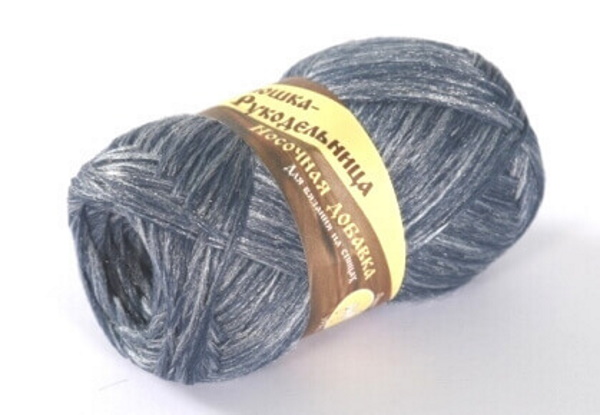
Experienced needlewomen prefer to knit socks with stocking needles. The standard set includes 5 short needles with 2 sharp tips. But in this case, it is difficult to work with circular needles, since the socks have a small diameter. It is better to prepare stocking needles No. 2 or 3, 15 to 20 cm long. Additionally, you can buy a needle with 2 tips or a large safety pin so that you can put aside loops while knitting the heel.
The fit of socks depends on what they were knitted from. For example, elastane with the addition of artificial fibers stretches well. Spandex combined with synthetic fibers resembles knitwear in its characteristics, but it is more elastic, and products made from this material are comfortable to wear.
If you knit socks from cashmere and natural wool, they will significantly decrease in volume after washing. Products made from cotton and synthetic fibers remember the shape of the foot.
Sizing
Men's knitted socks should be high-quality and warm, but they should also fit in size. That is why you need to first determine the length of the foot of the man who will wear this item of clothing. To do this, you need to put a piece of paper on the floor, stand on it with your foot and trace it with a marker. All that remains is to take a ruler and measure the distance from the end of the big toe to the most protruding point of the heel.

The results obtained should be compared with the data given in the table:
| Foot length (cm) | Men's Sock Size | Shoe size |
| 21-24 | 23 | 38-39 |
| 24-26 | 25 | 40-41 |
| 26-28 | 27 | 42-43 |
| 28-30 | 29 | 44-45 |
| 30-32 | 31 | 46-47 |
Only after determining the size of the socks can you start knitting.
How to determine the length of men's socks?
To knit socks that will be comfortable to wear, you need to know exactly how long this type of underwear should be. Otherwise, a person will be bothered by discomfort when walking, calluses and corns will appear. The development of a syndrome of prolonged compression of the lower extremities is not excluded. The length of men's socks should correspond to the length of the foot.
Experienced needlewomen recommend using a special table, which indicates the length of socks for each size of men's shoes:
| Shoe size | Length of socks |
| 40 | 26.7 |
| 41 | 27.3 |
| 42 | 28 |
| 43 | 28.7 |
| 44 | 29.3 |
| 45 | 30 |
| 46 | 31 |
| 47 | 31.7 |
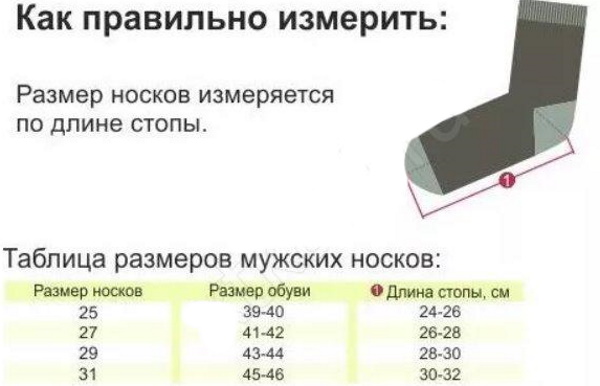
Measuring the foot length should be done at the first stage so that the amount of yarn required can be calculated correctly from the start.
Patterns, designs, techniques
Socks are knitted with a garter stitch in 95% of cases, but the cuffs are made in the form of a 2x2 elastic band, consisting of front and back loops. But over the past few years, experienced needlewomen have created many new models of men's socks using various patterns. At the same time, preference is given to brutal patterns that are easy to knit with knitting needles if you follow the recommendations described in the master classes.
To make men's socks, you can choose the following patterns and techniques:
- Patent patterns.
- Aran. When using this unique ancient technique of Irish knitting, you need to be prepared for the fact that you will need more yarn than for those items that were knitted using the classic stockinette stitch.
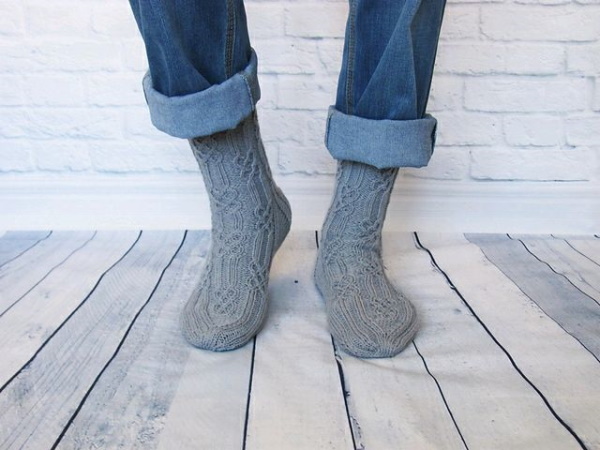
Men's knitted socks can be decorated with arans, a unique ancient technique of Irish knitting. - Openwork patterns are acceptable when knitting men's socks, but they should not be flashy and as laconic as possible.
- Brioche. This technique involves knitting with threads of one color or with the use of yarn of a contrasting color. The pattern of the fabric is the same on both sides, the difference is in the distribution of the colors of the yarn.
- Jacquard. In this case, threads of two or more colors are used for knitting. Jacquard products are warm. In the process of multi-color knitting, it is necessary to monitor the degree of tension of the threads so that the finished underwear does not turn out to be tight.
Some needlewomen prefer to knit socks 1 size larger, and then felt them, having previously washed them in hot water. Only natural wool is used for the work, the fibers of which are felted. At the final stage, socks are obtained that are much warmer than classic underwear knitted with the front surface. Experienced needlewomen can knit socks in the enterlak style.
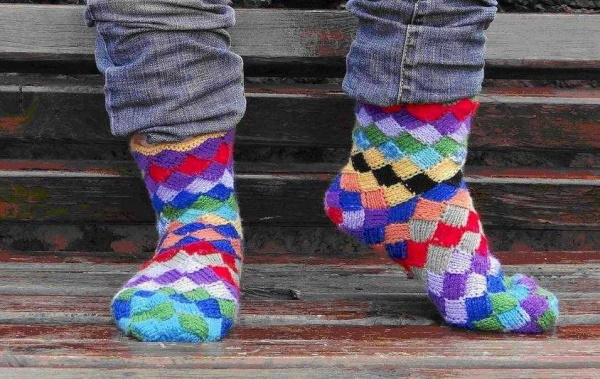
This is a type of patchwork that has recently become very popular, as it allows you to create original items with minimal effort. The principle of this knitting technique is to alternate multi-colored rectangular or square sectors. In addition to knitting needles, you will need pins for the removed loops. The yarn should be the same thickness, but different colors.
For knitting men's socks, it is better to choose a stockinette stitch, a discreet pattern on the front side. It is important to remember that it is not the pattern that makes a thing unique, but the texture and the dyeing method of the prepared yarn (sectional).
In order not to waste money, you need to calculate the amount of yarn required in advance. To do this, you need to take into account the size of the foot, the density of the future socks. The thinner the thread and the larger the foot size, the more yarn will be needed. If the needlewoman plans to knit an original relief pattern with arans, then you need to take 20% more yarn. In this case, the average weight of a skein is within 150 g. If the socks are high, then you need to buy at least 200-250 g of yarn.
How to knit with two needles with a seam?
Men's socks knitted with knitting needles with a neat seam are very warm and practical. To correctly calculate the loops (P), you need to measure the circumference of the ankle in the narrowest place and the height of the instep. The resulting numbers must be added up and then divided by 2.
As a result, you will get a number corresponding to the number of cm for which you need to calculate P according to the knitting pattern. If you follow the following scheme of actions, then you can make socks from 50 P (48 main + 2 edge) with a seam.
Further actions must be performed in a clear sequence:
- Knit a 2x2 elastic band, the length of which should be within 6 cm.
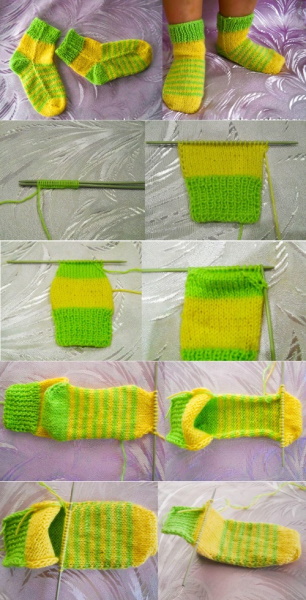
- You need to switch to the front surface (RS) and knit another 8 cm.
- To make the heel into 4 parts (Ч), you should divide the total number of loops (excluding edge loops). The heel of the future product will be formed into 2 middle Ч.
- You need to knit 3 ch (within 48 loops) with the front surface. The product being made needs to be turned over.
- Knit 2 middle Ch (24 loops), turn work.
- You need to try to reduce the length of the rows (P), knitting 1 less loop each time, so that 8 loops remain in the work.
- It is necessary to gradually increase the number of P, knitting the previously left P.
- To ensure that there are no gaps in the finished product, you need to put the side loop on the left knitting needle and knit it together with the front loop (FL).
- Turn the work and remove the first P + 8 purl.
- You need to pick up the side P and knit it with a purl loop (PL). Knit according to a similar pattern until all P are in work.
- The remaining R's are knitted with LG. The length of the knitted fabric of the future sock should cover half of the big toe.
- To knit the toe, you need to divide the knitting into 4 identical Ch.
- Let's start decreasing (UB). In even R's, from the end in 1 and 3 Ч 2, 3 loops knit together LP.
- In 2, 4 Ch 2, 3 P must be knitted together with a drawstring.
- If exactly half of the loops remain, then each subsequent R. is knitted according to a similar principle. After the manipulations performed, 6 P. should remain.
At the final stage, it remains to tighten the remaining 6 loops with a thread and sew the product. When knitting LG socks, you can create original jacquard patterns and ornaments. During the work, the threads will intertwine, due to which the knitted fabric will be warm and dense. The result will meet expectations if the yarn is soft and elastic. The threads should be of the same color. Particular attention should be paid to knitting the heel. Otherwise, the product will be unsuitable for wearing.
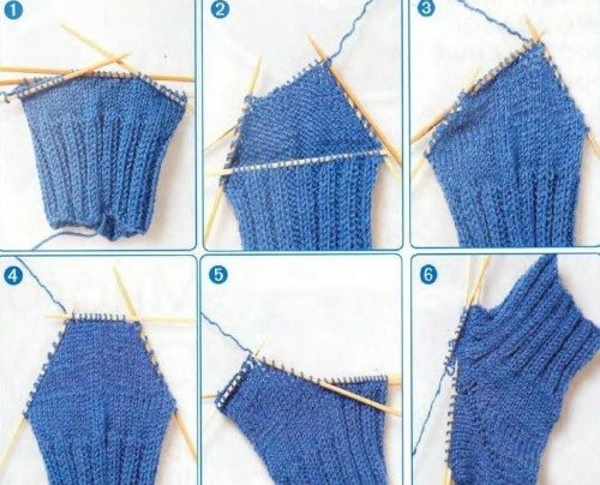
Experienced needlewomen recommend taking into account the nuances to avoid common mistakes:
- The total number of loops should be divided in half. For example, if there are 56, then 28 should remain. Further knitting of socks continues only on these loops.
- Knit the required number of rows. In 99% of cases, the heel height in socks is between 6 and 7 cm.
- The Ps in the work are divided by 3. However, 28 is not divisible by 3, which is why 10 Ps must be left on the middle needle, and 9 Ps are left on the side needles.
- All side P in each R are knitted 1 by those P that are cast on the central needle. After the actions are completed, all P should end on the side needles.
To make the socks the same, after the UB of the instep wedge, knit a R in accordance with the previously chosen pattern and put a marker on it. Thanks to this approach, it will be easier to control the number of knitted R of the foot. If a man has a shoe size of 43, then from the marker you need to knit 60 R in the front surface. You can try on the product to make sure that the knitted part covers the little toe on the foot. Particular attention in the knitting process should be paid to the strength of the toe, heel.
On two needles without a seam
Men's socks (knitted items will last longer if you turn them inside out before washing) can be knitted seamlessly using 2 knitting needles. To calculate P correctly, you need to follow the formula: (girth of the widest part of the foot x knitting density) / 2.
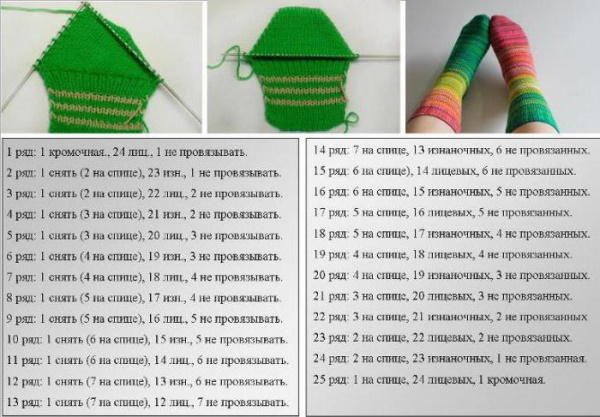
Using this technology, the back half of the sock is knitted step by step to the toe, and then the second half of the essential wardrobe element is created. Edge loops (EL) of the finished item should be fixed along the edges.
The knitting pattern looks like this:
- Knit a cuff. You need to dial the basic number of P. Half of the cuff can be knitted with an elastic band, making sure that the product has the desired width.
- The edge of the knitted product should have the shape of a braid (even edge). The first loop is not knitted, but removed. The last P should be purl. Due to this, it will be possible to create a neat connection of all the parts of the sock.
- Forming the heel. This stage is the most labor-intensive for needlewomen who do not have the necessary experience. To calculate the appropriate heel height, you need to follow the scheme: from the total number of P on the knitting needle, you need to subtract 2 P (for an even number) or 3 (for an odd number).
- LG knit all R heels. All P are divided into 3 Ch. If 1 loop is left unused, then it can be added to the middle Ch, and if 2, then 1 P to the side Ch.
- Using markers, mark the number of P in the middle Ch. The first side Ch is knitted without changes to LG. The first loops of the middle Ch need to be knitted LG, and the last P should be connected to the adjacent P from the second side Ch.
- Turn the knitting to itself with the wrong side. Carefully remove the first P without knitting. Next, you need to knit the IP. The side loops must be continued 1 by 1, attached to the middle Ch, so that in the work there are as many P as were initially collected for the middle Ch.
- Knitting socks. There are no difficulties in creating a half-length Ch of socks, since you just need to knit a piece of fabric of a certain length. To do this, in the first R, lift P from the edge, but only on one side of the heel. The knitted fabric is turned.
- If P is purl, then knit IP. Now on the other side you need to lift P from KrP.
- In all even R along the edge, knit 2 P LG together (P should be tilted to the left). For IR, knit 2 IP.
- Everything is done correctly if in the end the same number of P remains as in the first stage.
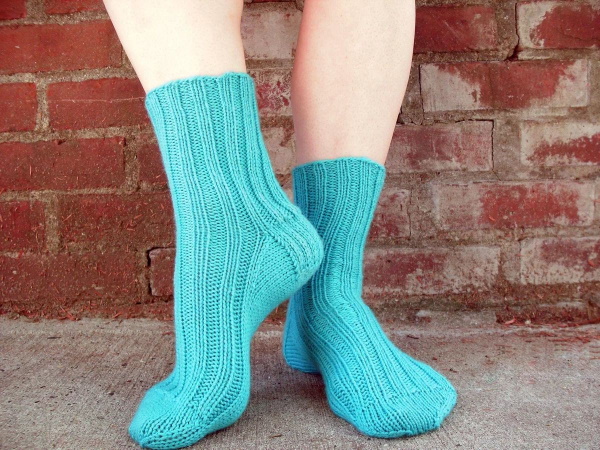
To create a sock, you need to correctly calculate its length by measuring the parameters of the heel cup and foot. The length of the cup is multiplied by 2. The obtained data is subtracted from the already known parameters of the foot. The final number will correspond to the length of the middle Ch of the sock, which is to be knitted LG. In the process of creating the toe, all bevels should be smooth. On both sides of the KrP in each even R, UB is made until 30% of P from the original set remains.
After this, you need to knit in the direction of the cuff, gradually making the upper part of the sock:
- It is necessary to add P from the drawstrings (an arched section of the working thread between two P) along the edges using the same technology as the reduction of the toe in each even R. The drawstring should be twisted and knitted so that gaps do not form in the places of the increase.
- At the same time as connecting the parts, you need to make increases by pulling out a new P from one KRP of the finished fabric.
- The number of loops should be controlled. The increase is stopped when the number of loops in the work is the same as when making the sock.
- The top of the sock is knitted in a straight line, connecting all the elements of the product along the edge.
- Loops should not be added, otherwise the product will be spoiled. In order for the total number of P in the work to always be calculated, it is necessary to connect 2 P at the end of each R.
- You need to hook the KrP (directed to the front side) behind the wall on the section with the elastic band, knitting it together with the last P of the row.
- For the following P, each first P is knitted so that the pattern created is continuous.
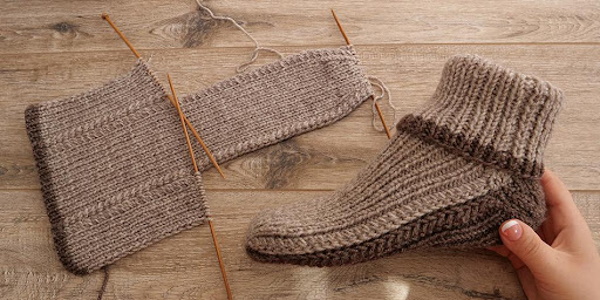
There are many models of stylish, warm socks that can be knitted with knitting needles. For example, without a seam, with a seam, with a toe, on circular knitting needles, with an ornament. In each case, a detailed master class with a scheme of actions is provided. Socks may not have a heel, due to which a slight one-size-fits-all product can be achieved, but you need to guess with the width.
This option is especially relevant if you decide to knit socks as a gift. But before you start knitting yourself, you need to prepare all the necessary tools, materials, and also calculate the number of P as accurately as possible. Thanks to this, you can knit high-quality men's socks in a few evenings, which will be original and comfortable.
Video on how to knit men's socks
How to knit men's socks with knitting needles:
